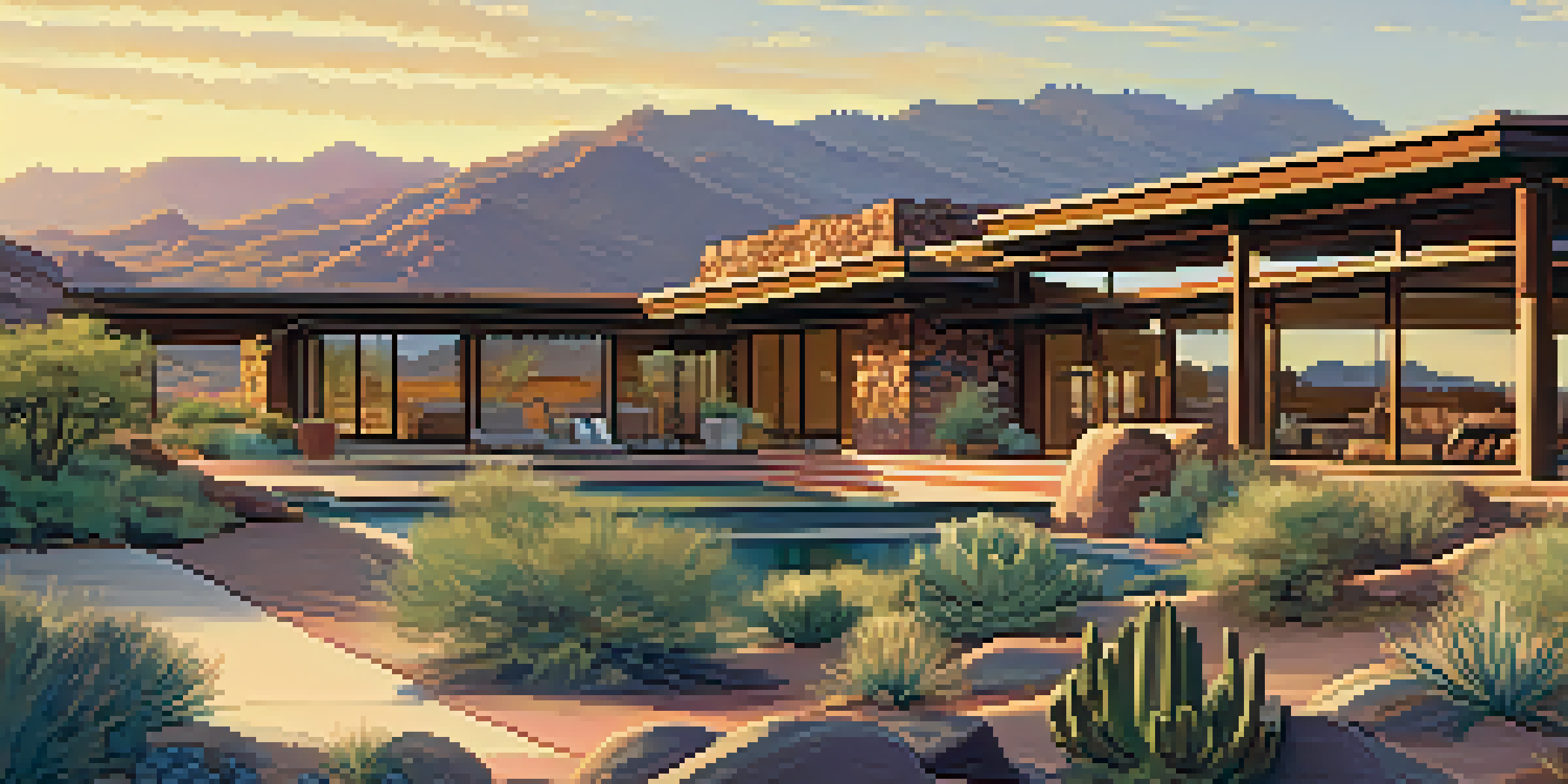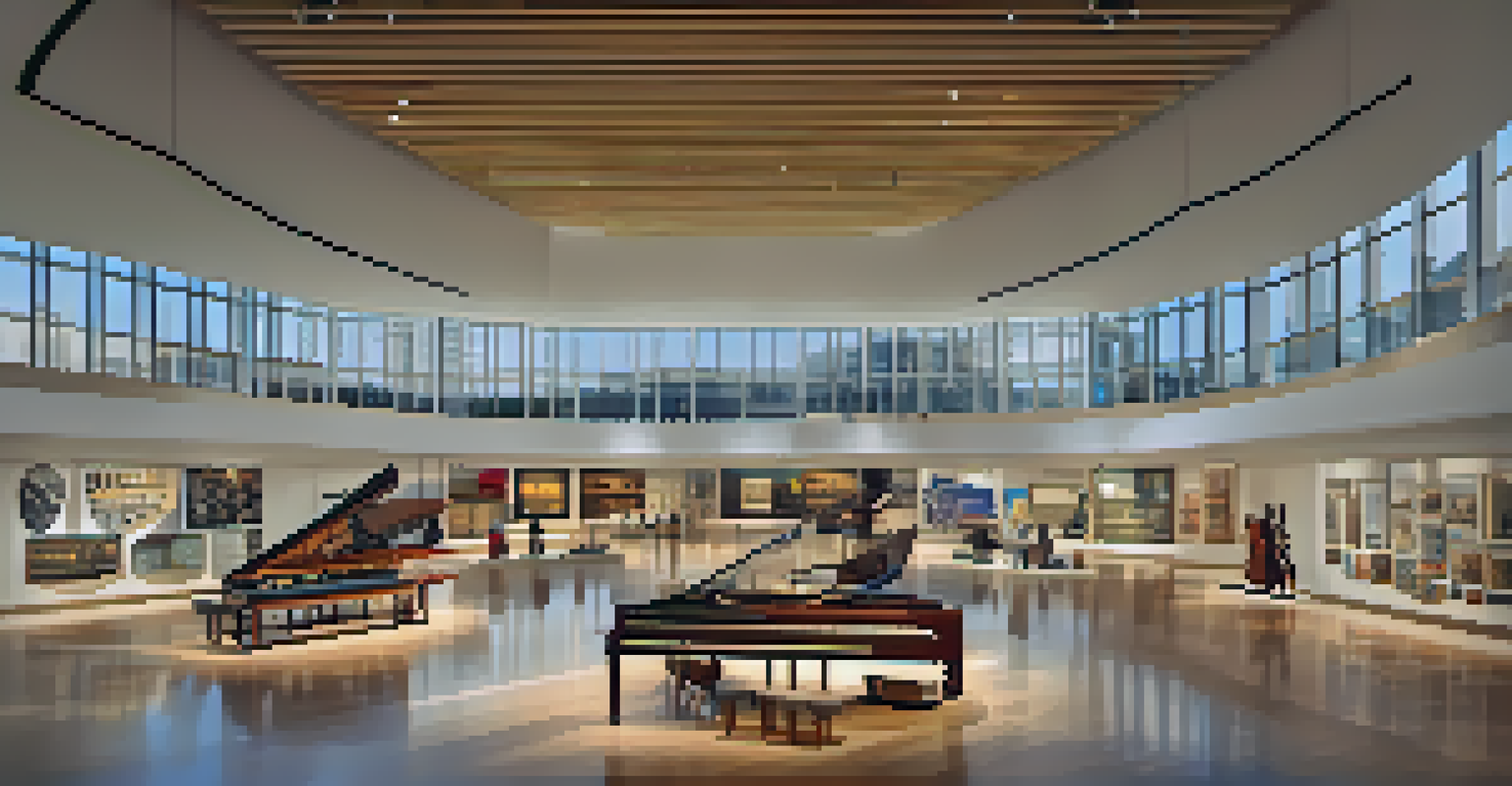Iconic Arizona Buildings That Redefined Modern Architecture

Taliesin West: Frank Lloyd Wright's Desert Masterpiece
Nestled in the foothills of the McDowell Mountains, Taliesin West stands as a testament to Frank Lloyd Wright's innovative vision. Built in 1937, this architectural marvel served as Wright's winter home and architectural school. The structure harmonizes with its desert surroundings, using local materials and blending seamlessly with the landscape.
The mother art is architecture. Without an architecture of our own, we have no soul of our own civilization.
Wright's use of natural elements not only defined the building's aesthetic but also reflected his philosophy of organic architecture. The open spaces, cantilevered roofs, and extensive use of natural light create an inviting atmosphere. Visitors often describe the experience as walking through a living piece of art, where nature and architecture dance together.
Today, Taliesin West is a UNESCO World Heritage site, attracting architecture enthusiasts from around the globe. It showcases Wright's ability to rethink traditional design, making it a cornerstone of modern architecture. The site also offers tours and educational programs, inviting a new generation to appreciate this architectural gem.
The Arizona State Capitol: A Blend of History and Modernism
The Arizona State Capitol, completed in 1901, is a remarkable blend of history and modernism that reflects the state's evolution. Its neoclassical design, with a striking copper dome, symbolizes Arizona's journey from territory to statehood. The building is not just an office space; it's a monument to the aspirations of its time.

Inside, the Capitol houses historical artifacts that tell the story of Arizona's vibrant past. The rotunda's impressive murals and intricate sculptures celebrate the state's cultural diversity and natural beauty. This melding of art and architecture creates an inspiring environment for both legislators and visitors.
Wright's Legacy in Arizona Architecture
Frank Lloyd Wright's designs, such as Taliesin West and Grady Gammage Memorial Auditorium, showcase his innovative approach to blending architecture with the natural environment.
In recent years, the Capitol has undergone renovations to modernize its facilities while preserving its historic charm. This balance of old and new demonstrates how architecture can evolve alongside society. It stands as a reminder that the past is integral to shaping the future.
The Desert Botanical Garden: Nature Meets Design
Located in Phoenix, the Desert Botanical Garden is an extraordinary example of how architecture can enhance the natural environment. Designed by the renowned architect, Frank Lloyd Wright's protégé, the garden features a series of structures that complement its stunning desert landscape. The use of local materials and sustainable practices underscores the importance of ecological harmony.
Architecture is the learned game, correct and magnificent, of forms assembled in the light.
Visitors are greeted with stunning views of native plants while wandering through the garden's winding pathways. The architectural elements, such as the visitor center, are designed to blend seamlessly with the surroundings, creating a serene atmosphere. This thoughtful integration of design encourages visitors to connect with nature on a deeper level.
The Desert Botanical Garden also serves as a venue for art installations and cultural events, further enriching the community's connection to the space. By redefining the relationship between architecture and landscape, this garden exemplifies how modern design can celebrate and preserve the environment.
Phoenix Central Library: A Beacon of Modern Design
The Phoenix Central Library, completed in 1995, is a remarkable example of modern architecture that prioritizes community engagement. Designed by architect Will Bruder, its bold, geometric design stands out in the downtown area. The library's innovative use of space and light creates an inviting atmosphere for visitors of all ages.
With its towering bookshelves and vibrant reading areas, the library encourages exploration and learning. The design emphasizes transparency, with large windows that provide natural light and views of the surrounding cityscape. This connection to the outside world invites the community to participate in the library’s offerings.
Historical Significance of State Capitol
The Arizona State Capitol stands as a reflection of the state's evolution, combining neoclassical design with modern renovations that honor its historical roots.
In addition to its architectural prowess, the library hosts numerous events and programs that foster a love for reading and learning. By redefining what a library can be, the Phoenix Central Library has become a vital hub for education and creativity in the city. Its impact on modern architecture is a testament to the evolving role of public spaces.
The Heard Museum: Celebrating Native American Culture
The Heard Museum in Phoenix is an architectural gem that celebrates Native American culture and art. Opened in 1929, the museum has undergone significant renovations, blending traditional and modern design elements. Its adobe-style architecture pays homage to the region's indigenous heritage while providing a contemporary space for exhibitions.
The museum's galleries showcase an impressive collection of Native American artifacts, art, and history. The layout encourages visitors to engage with the exhibits, creating an immersive experience. The thoughtful design not only honors the past but also fosters appreciation for Native cultures in a modern context.
In addition to its exhibitions, the Heard Museum hosts cultural events and educational programs that further enrich the community's understanding of Native American traditions. By redefining museum space, the Heard Museum has become a pivotal institution for cultural education in Arizona. Its architectural significance lies in its ability to honor the past while embracing the future.
ASU’s Grady Gammage Memorial Auditorium: A Wright Legacy
Grady Gammage Memorial Auditorium, designed by Frank Lloyd Wright and completed in 1964, is a stunning example of modern architecture at Arizona State University. The auditorium's unique design features a circular shape and a striking roof that resembles a tent, symbolizing the spirit of the American Southwest. Wright's vision was to create a space that harmonized with its desert surroundings while serving as a cultural hub.
Inside, the auditorium boasts exceptional acoustics and seating that offers a clear view of the stage from every angle. This design enhances the experience for both performers and audiences, making it a popular venue for concerts and events. The building's architectural beauty invites visitors to appreciate not only the performances but also the space itself.
Cultural Enrichment through Design
Museums like the Heard Museum and the Musical Instrument Museum highlight how architecture can celebrate and educate communities about cultural heritage.
Grady Gammage remains a vital part of the ASU community, hosting a variety of events that enrich the cultural landscape of Arizona. Its iconic design and continued relevance in the arts underscore Wright's enduring influence on modern architecture. The auditorium exemplifies how innovative design can create lasting cultural impacts.
The Musical Instrument Museum: A Symphony of Design
The Musical Instrument Museum (MIM) in Phoenix is a stunning architectural achievement that celebrates the world's diverse musical heritage. Opened in 2010, the museum features a modern design that invites visitors to explore the global history of music through interactive exhibits. The building's fluid forms and open spaces create an engaging environment for learning and discovery.
MIM's design prioritizes the visitor experience, with carefully curated exhibits that encourage exploration. The unique layout allows guests to journey through different cultures and time periods, all while surrounded by beautiful architectural elements. This integration of design and function enhances the overall experience, making each visit memorable.

In addition to its impressive architecture, MIM hosts concerts and educational programs, further enriching the community's connection to music. By redefining what a museum can be, the Musical Instrument Museum stands as a testament to modern architectural innovation. It beautifully illustrates how design can celebrate culture and foster a sense of community.
Scottsdale Waterfront: Where Nature Meets Urban Design
The Scottsdale Waterfront is an innovative urban development that exemplifies modern architectural principles while celebrating the beauty of the desert landscape. This vibrant area integrates parks, shops, and residences along the picturesque Arizona Canal, creating a dynamic space for both locals and visitors. The careful planning and design emphasize sustainability and community engagement.
With its pedestrian-friendly layout and inviting public spaces, the Scottsdale Waterfront encourages outdoor activities and social interactions. The modern architecture of the buildings complements the surrounding natural beauty, creating a harmonious blend of urban and natural elements. This thoughtful design enhances the overall experience for those who enjoy the area.
The Waterfront is not just a place to live and shop; it's a cultural hub that hosts events, art installations, and festivals throughout the year. By redefining urban space, the Scottsdale Waterfront demonstrates how modern architecture can foster community connections. It serves as a model for future developments that prioritize sustainability and inclusivity.